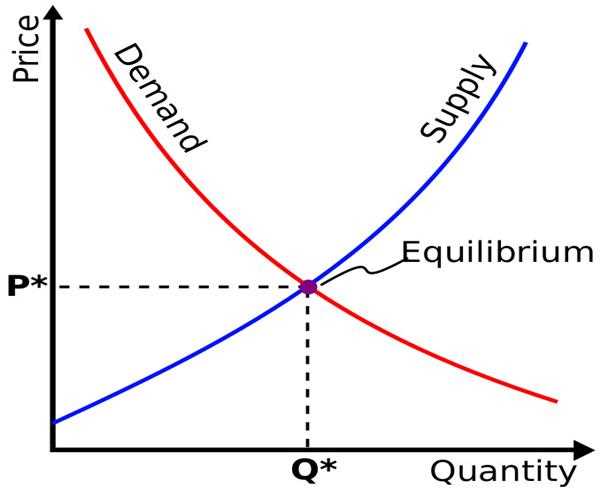To understand how prices are affected by supply and demand, one needs to know what the Law of Supply and Demand is.
Law of Supply and Demand
According to the Law of Supply and Demand in Economics, the price of goods will ultimately settle in a state that allows Supply to be equal to the Demand (called the Market-Clearing Price). In simpler words, if supply of goods or services is higher than demand, prices will fall, and vice versa.
The demand-supply curve can be plotted on a graph, as follows. The point at which they cross is the Economic Equilibrium or the Market-Clearing Price. The supply and demand will always try to move to the equilibrium.

Impact of Supply and Demand on Prices
Both supply and demand have an inverse relationship with prices if the other remains unchanged.
- If supply increases and demand stays the same, the price will decrease.
- If supply decreases and demand stays the same, the price will increase.
- If demand increases and supply stays the same, the price will increase.
- If demand decreases and supply stays the same, the price will decrease.
It is important to note that prices will fluctuate for some time before settling into a market-clearing price. There is also the concept of Price Elasticity.
Price Elasticity of Demand
Usually, when prices are raised, the demand decreases (and vice versa). However, the extent to which demand changes is different for each product. Price Elasticity of Demand measures how sensitive the demand is to changes in price. If the demand changes by a lot when prices change, it is known as an Elastic price. Conversely, if the demand sees little change, it is known as an Inelastic price.
Exceptions
While the Law of Supply and Demand is a powerful tool, it is not infallible and has quite a few exceptions affecting the cost of an item. This rule works under the assumption that consumers have full knowledge of products and that there are no regulations imposed on the product. If these assumptions are wrong, the law falls apart and leads to exceptions. Some of these exceptions are:
Public Perception
- Misinformation: If a consumer’s knowledge of the supply of a particular goods is incorrect, it affects the demand as well. If people think a particular item is facing a shortage, the demand for it will rise, affecting its prices as well.
- Lack of Information: If an item is in high demand, but the consumer does not know about the particular item, then the demand will not affect the prices.
Fettered Markets
- Monopoly: If a company has established a monopoly on a product, it can maintain high prices regardless of its demand. A good example of it is expensive medication (like Insulin and Epinephrin in America, or life-saving medication before DPCO)
- Price Controls: The government sometimes sets rules to control prices, which either increases or decreases its supply. An example of a Price Control is the Drugs Price Control Order (DPCO).
- Planned Economies: There is no concept of supply and demand in a planned economy, as the central authority dictates supply and demand instead.
Conclusion
The price of goods is ultimately decided by the supply of said goods and its demand. Supply and demand have an inverse relationship. When supply increases and demand stays the same, prices decrease, and vice versa. When demand increases and supply stays the same, prices increase. However, there are exceptions to this, like monopolies, where the prices are not controlled by supply and demand.